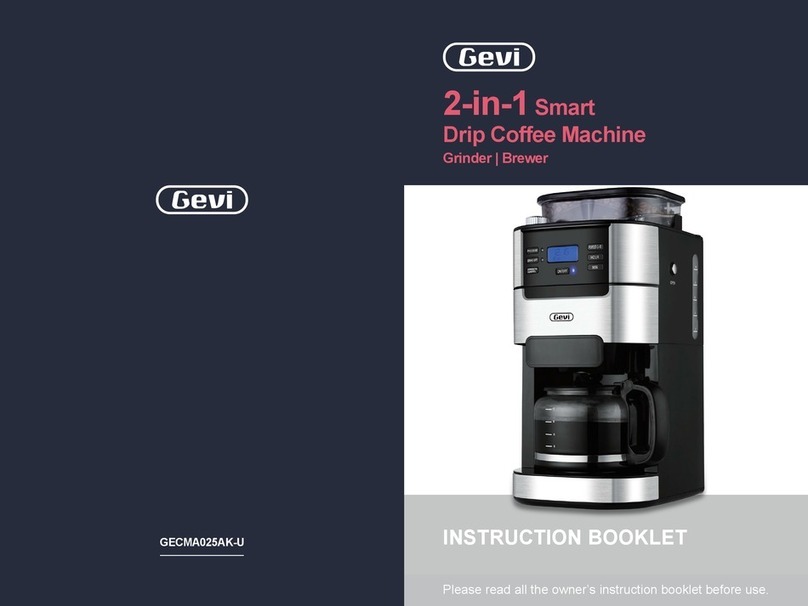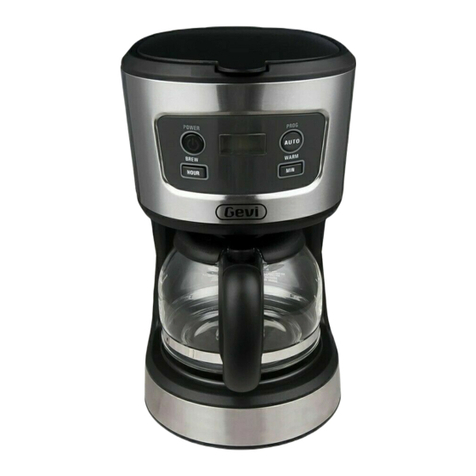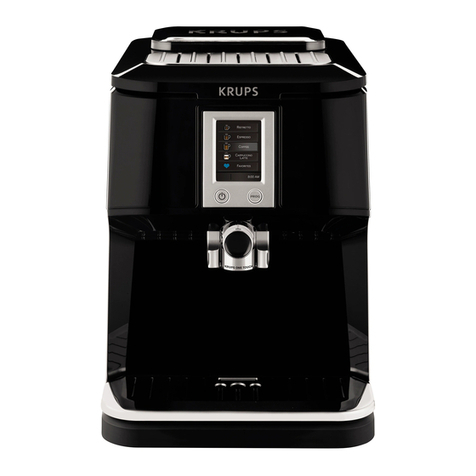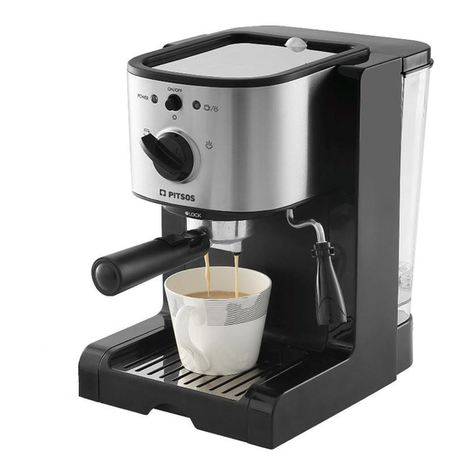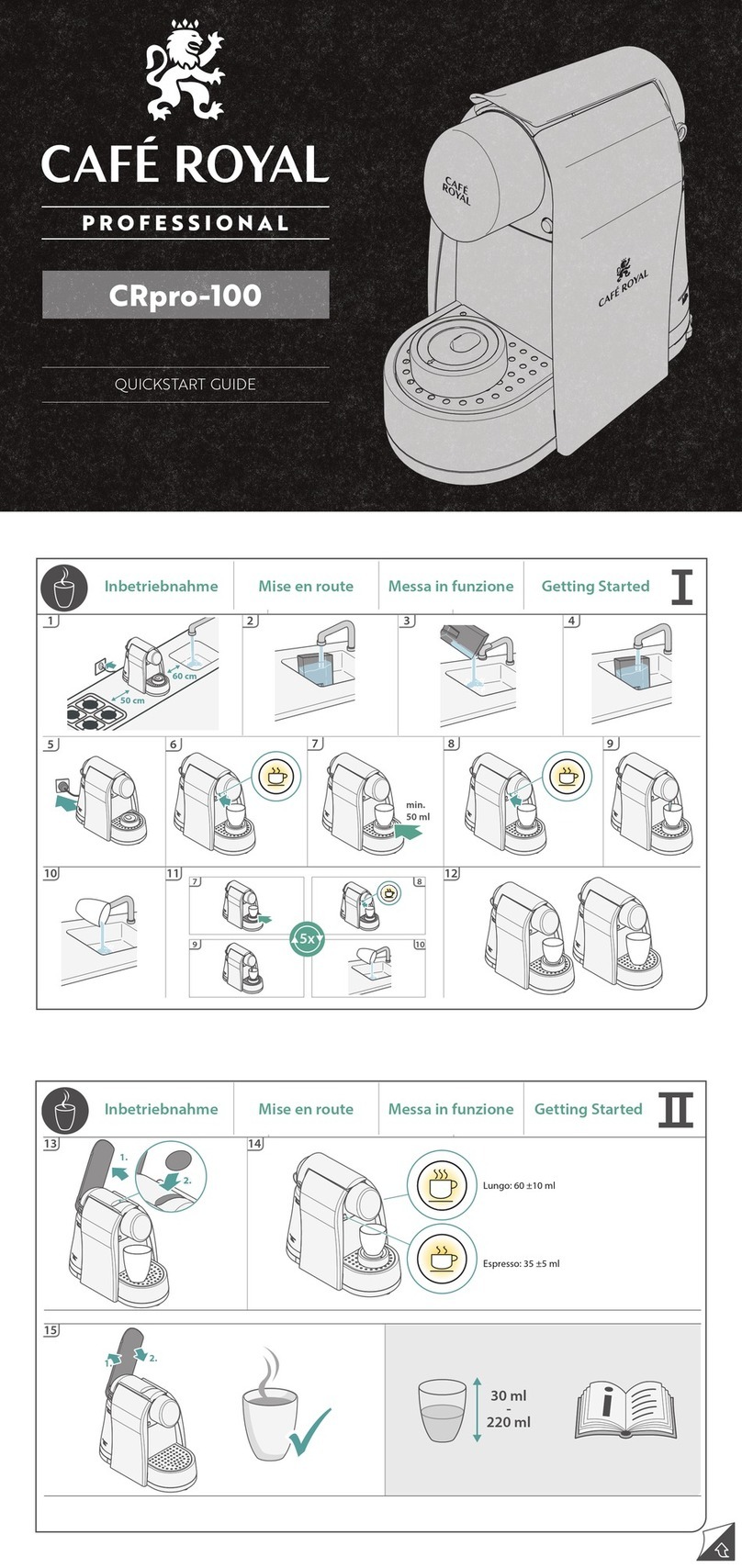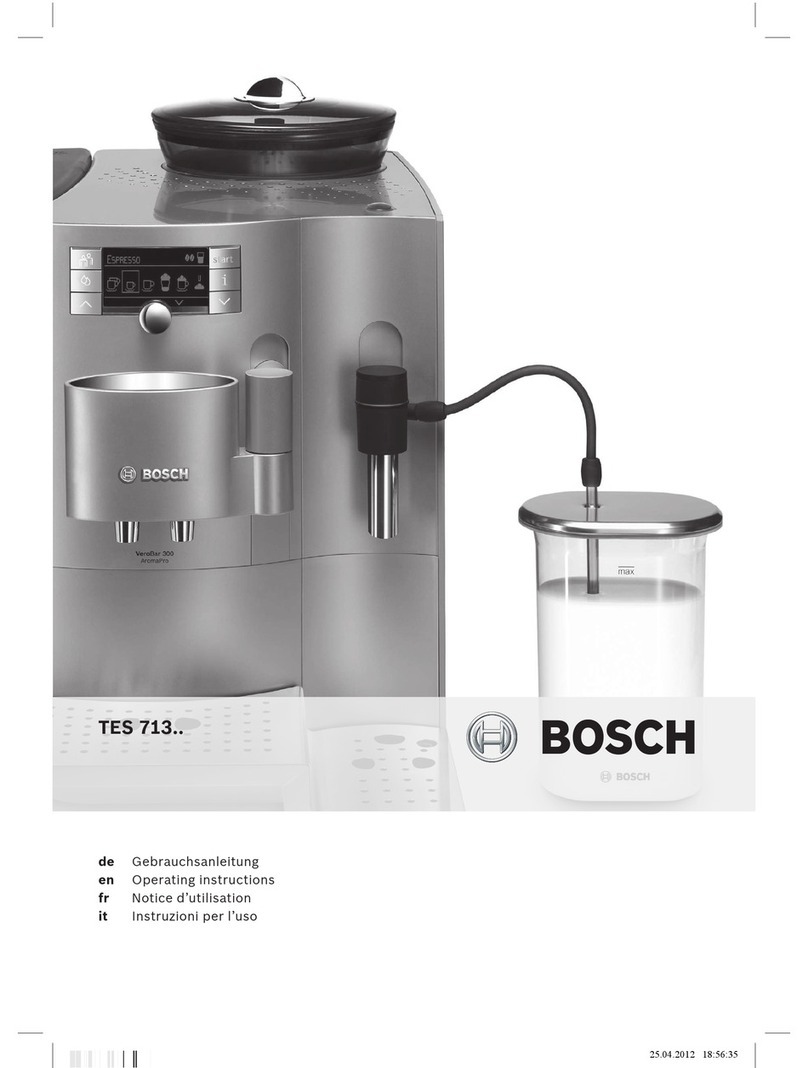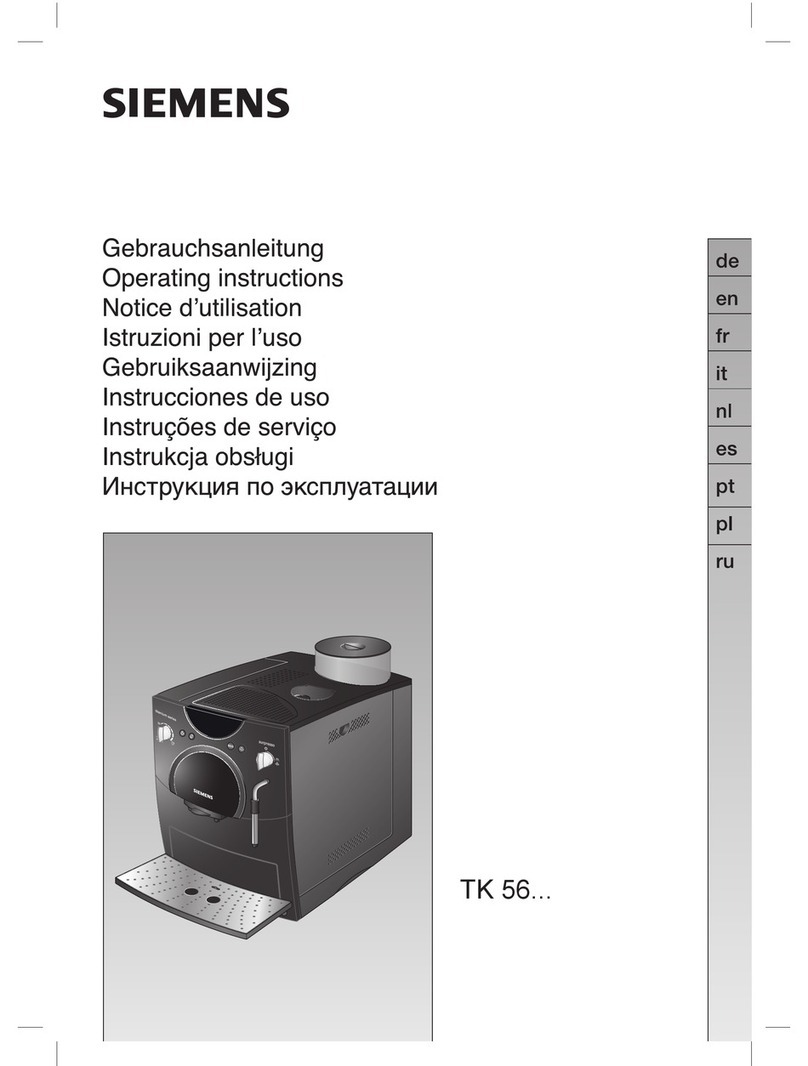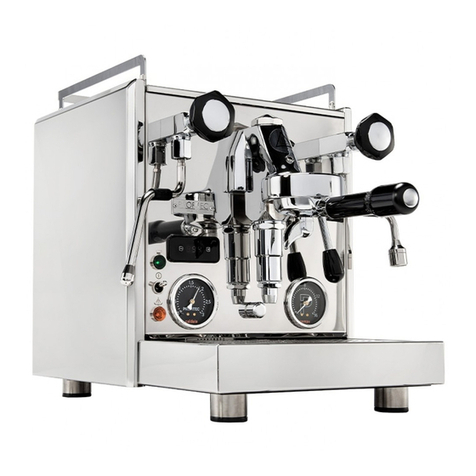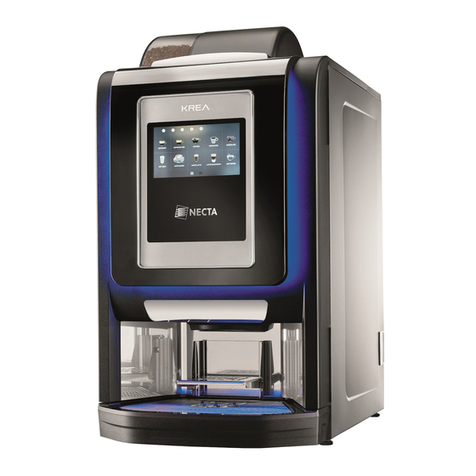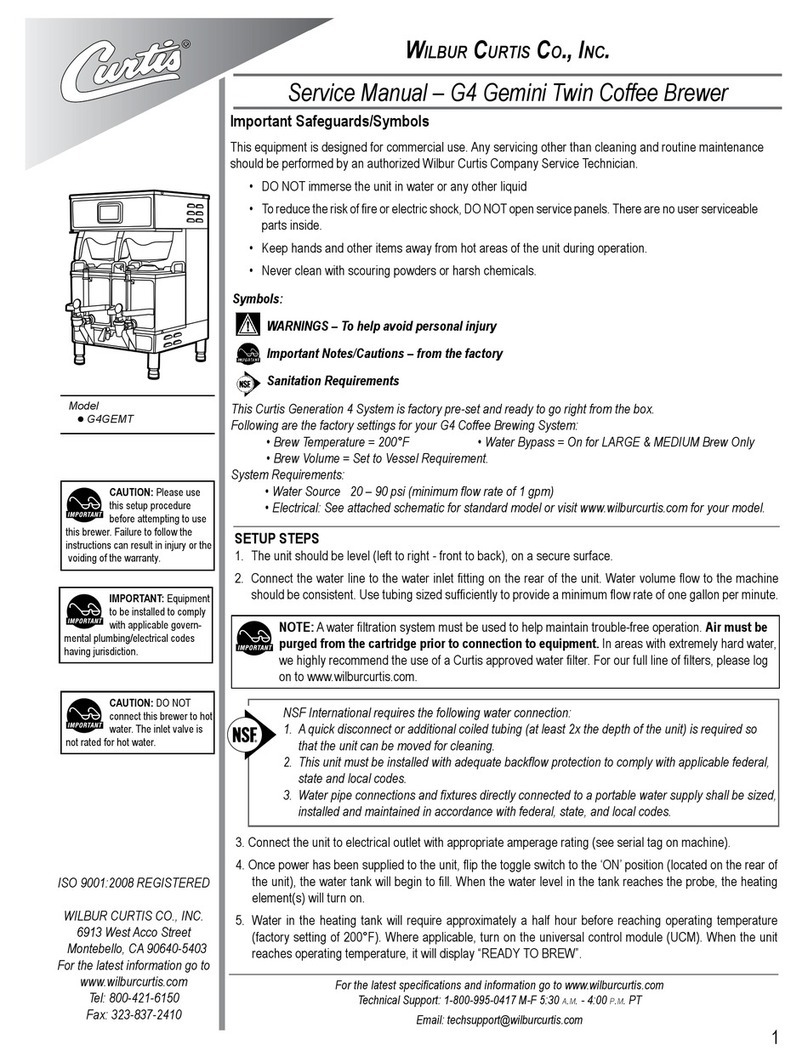Gevi GECME003D-U User manual

INSTRUCTION BOOKLET
Please read all the owner’s instruction booklet before use.
2-in-1 Smart
Espresso Coffee Machine
Brewer | Frother
GECME003D-U

1. Important Safeguards
2. Know Your Machine
3. More Details
4. Before First Use
5. Espresso Making Guide
6. Milk Frothing Guide
7. Other Functions
7.1 High-temperature Alarm Guide
7.2 Pre-infusion Function
8. Cleaning & Maintenance
9. Troubleshooting
10. Warranty
11. Coffees To Try
Table of Contents
. . . . . . . . . . . . . . . . . . . . . . . . . . . . . . . . . . . . . . . . . 01
. . . . . . . . . . . . . . . . . . . . . . . . . . . . . . . . . . . . . . . . . . . . . . . 25
. . . . . . . . . . . . . . . . . . . . . . . . . . . . . . . . . . . . . . . . . . . 05
. . . . . . . . . . . . . . . . . . . . . . . . . . . . . . . . . . . . . . . . . . . . . . . . . . . 07
. . . . . . . . . . . . . . . . . . . . . . . . . . . . . . . . . . . . . . . . . . . . . . . 09
. . . . . . . . . . . . . . . . . . . . . . . . . . . . . . . . . . . . . . 26
. . . . . . . . . . . . . . . . . . . . . . . . . . . . . . . . . . . . . . . . . . . 21
. . . . . . . . . . . . . . . . . . . . . . . . . . . . . . . . . . . . . . . . . . . . . . . . 48
. . . . . . . . . . . . . . . . . . . . . . . . . . . . . . . . . . . . . . . . 26
. . . . . . . . . . . . . . . . . . . . . . . . . . . . . . . . . . . . . . . . . . . . . . 39
. . . . . . . . . . . . . . . . . . . . . . . . . . . . . . . . . . . . . . . . . . . . . . . . . . . . 46
. . . . . . . . . . . . . . . . . . . . . . . . . . . . . . . 25
. . . . . . . . . . . . . . . . . . . . . . . . . . . . . . . . . . . . . . . . 11

21
1. Important Safeguards 1. Important Safeguards
When using electrical machines, basic safety precautions should
always be followed to reduce the risk of fire, electric shock, and/
or injury to persons including the following:
1. Read all instructions before using this machine.
2. Do not touch hot surfaces. Use handles or knobs.
3. Do not leave the machine unattended when in use.
4. Never use the espresso machine without water in the water tank.
5. To protect against electric shock, do not place or immerse cord,
plugs, or machine in water or other liquid.
6. Before using, check the output voltage of the wall outlet should
be correspond to the rated voltage marked on the machine’s
rating plate.
7. This machine is not intended for use by children or by persons
with reduced physical, sensory, or mental capabilities, or lack of
experience and knowledge. Close supervision is necessary when
any machine is used near children. Children should be supervised
to ensure that they do not play with the machine. Keep the machine
and its cord out of reach of children.
8. Unplug from outlet when either the machine or display clock (if
provided) is not in use, and before cleaning. Allow to cool before
putting on or taking off parts, and before cleaning the machine.
9. Do not operate any machine with a damaged cord or plug or after
the machine malfunctions, or has been damaged in any manner.
Do not attempt to replace or splice a damaged cord. Return machine
to an Authorized Service Center for examination, repair or adjustment.
10. The use of an accessory not recommended by the machine
manufacturer for use with this machine may result in fire, electric
shock or injury to persons.
11. Do not use outdoors or for commercial purposes.
12. Do not let cord hang over edge of table or counter, or touch hot
surfaces.
13. Do not place on or near a hot gas or electric burner, or in a heated
oven.
14. Be careful not to get burned by the steam.
15. Do not touch the hot surface of the steam wand and filter holder
when boiling directly. Use handle or knobs.
16. Relieve pressure through steam wand before removing portafilter.
17. Always attach plug to machine first, then plug cord into the wall
outlet (for machines with detachable cords). To disconnect, turn
any control to the off position, then remove plug from wall outlet.
18. To eliminate a choking hazard for young children, remove and
safely discard the protective cover fitted to the power plug of the
espresso machine.
19. Do not use machine for other than intended use. Misuse can cause
injuries.
20. Never remove the portafilter during the brewing operation as the
machine is under pressure.
WARNING
Always properly engage the Group Head to the locking mechanism.
Failure to do so may disengage the Group Head during the brew cycle
and cause injuries.

43
21. Models intended to be used with sealed capsules: Only use
capsules intended for this machine. If the capsule does not fit,
do not force the capsule into the machine.
22. Models with coffee grinders: Check hopper for presence of foreign
objects before using.
23. Household Use Only.
For machines with service panels:
1. Place the machine on a hard, flat, level surface to avoid interru-
ption of airflow underneath the espresso maker.
2. Do not operate the machine with an empty water tank.
A short power-supply cord (or detachable power-supply cord) may
be provided to reduce risks resulting from becoming entangled in or
tripping over a longer cord. Longer detachable power- supply cords
or extension cords are available and may be used if care is exercised
in their use. If a long detachable power-supply cord or extension cord
is used:
1. Important Safeguards 1. Important Safeguards
WARNING
TO REDUCE THE RISK OF FIRE OR ELECTRIC SHOCK, DO NOT REMOVE
THIS COVER. NO USER‒SERVICEABLE PARTS INSIDE. REPAIR SHOULD
BE DONE BY AUTHORIZED SERVICE PERSONNEL ONLY.
NOTE
For electronic instruction manual, please contact Gevi support team.
North American models with grounded plugs:
POWER CORD INSTRUCTIONS:
PRODUCT NOTICES
This machine has a polarized plug, (one blade is
wider than the other). As a safety feature to reduce
the risk of electrical shock, this plug is intended to fit in a polarized outlet only
one way. If the plug does not fit fully in the outlet, reverse the plug. If it still does
not fit, contact a qualified electrician. Do not attempt to defeat this safety feature
or modify the plug in any way. If the plug fits loosely into the AC outlet or if the
AC outlet feels warm do not use that outlet.
POLARIZED PLUG
a. The marked electrical rating of the detachable power-supply cord
or extension cord should be at least as great as the electrical rating
of the machine;
b. If the machine is of the grounded type, the extension cord should
be a grounding type 3-wire cord;
c. The longer cord should be arranged so that it will not drape over
the counter top or table top where it can be pulled on by children
or tripped over unintentionally.
Do not pull, twist or otherwise abuse the power cord.

❿ ⓬ ⓭⓫ ⓮
⓬
⓭
⓮
❼
❽
❾
❶
❺
❹
❷
❸
❻
51mm Double
Cup Filter
Spoon &
Tamper
Re. Description Specification
2. Know Your Machine 2. Know Your Machine
65
❺On/Off Button Press the On/Off button to turn on/off the machine.
Steam Wand
❼
❾Froth Nozzle
❿MAKING ESPRESSO
Button
Removable Drip
Tray
❻Includes a buoy that will float through the grill
when it is full and requires emptying.
Ball joint movement with a stainless steel cover.
Able to create silky smooth micro-foam in the milk
under the right steam pressure.
Allows for moving the steam wand without
burning fingers.
Heat resistant and convenient to rotate.
The button's light will flash blue when the machine
is heating up. The button's light steadily illuminates
blue when the machine is in the READY state.
The Espresso Indicator steadily illuminates blue
when the machine is making espresso.
Used to activate espresso or steam.
The Frothing Indicator steadily illuminates white
when the machine is frothing milk.
The button's light steadily illuminates white when
the machine is ready for frothing milk.
⓫Espresso Indicator
Espresso/Steam
Knob
Frothing Indicator
MILK FROTHING
Button
❷Tank Handle Lift it upwards when removing the water tank.
❽Heat Resistant
Handle
Cup Warming Plate
❶Preheats cups and glasses to help retain essential
characteristics of true espresso aroma for a rich,
sweet taste.
❸Removable Water
Tank
Push back the tank lid & fill with clean water, or
remove the water tank by opening the lid.
❹Group Head
Compatible with coffee grinds or pod espresso.
Has two positions, lock and unlock, for easy
cleaning.
Electrical Parameters: 120V~ 60Hz 1050W
Model: GECME003D-U
Cleaning
Pin

87
3. More Details3. More Details
Thermoblock Fast Heating
System
- The thermoblock heats the water so that the espr-
esso extracts at 198°F (just below boiling point) for
optimum extraction of oils from the coffee grinds.
Temperatures above this will burn the grinds resul-
ting in a bitter taste.
- The thermoblock is fitted with a PID controller
which continually monitors the water temperature
to ensure water is always delivered to the coffee gr-
inds at the precise temperature needed.
15 BAR Pump
The thermoblock works in conjunction with the
pump to deliver the correct water temperature
at the correct pressure for complete extraction
of oils,coffee solids and aroma.
1050W Big Power
1050W big power can provide a fast and stable extra-
ction, making espresso more fragrant and richer in
crema.
Safe Protection System
The machine will automatically power off after
25 minutes, automatic pressure relief protection
to avoid water leakage.
Overheat protection to prevent dry burning.
Filter Basket
The filter basket allows a more consistent grind
compaction, resulting in a better tasty coffee.
Used espresso pucks can be easily emptied.
2 Separate Thermostats
More precise to control water and steam tempe-
rature separately. Espresso extraction temperat-
ure control for improving crema extraction is 197℉.
Milk frothing temperature control for making a
delicate foam is 212℉.
Pre-Infusion
Small amounts of water are released onto the
tamped coffee grinds prior to the steady flow of
water, for a richer flavored espresso.
2-in-1 Portafilter
The Portafilter holds coffee grinds for a true cafe
tasting coffee. Its perfect size ensures the grinds
are more evenly spread and easier to fill for imp-
orved flavor extraction.
Stainless Steel Design
Convenient storage, suitable for home kitchens.
Powerful Steam Wand
Stainless steel steam wand for effortless milk
frothing.

109
4. Before First Use
Step 4 - Set up the water tank vertically and align the buckles
to the hole on the back of the machine, and then press it
down to be parallel to the top of the machine.
Step 1 - Make sure the knob is in the " " icon position.
Step 2 - Insert the Power Plug into a 120V AC power outlet
& switch the power on.
Step 3 - Press the ON/OFF button to the “ — ” position to
turn on the machine.
- The MAKING ESPRESSO button's light will flash
blue, the machine will start heating.
- When MAKING ESPRESSO button's light is blue
on, the machine is in READY state.(the default setting is brewing espresso).
More simply, the water tank can also be filled without
being extracted by pouring the water directly from a jug.
NOTE
• Power
Step 1 - Align the marking dot on the filter with the portafilter's
groove, and then install the filter to the portafilter, twist
and fix the filter.
Step 2 - Hold the machine with one hand and the portafilter
with the other hand.
Step 3 - Place the portafilter underneath the group head
so that the handle is aligned with the INSERT position. Insert
the portafilter into the group head and rotate the handle
towards the center until resistance is felt.
• Insert Portafilter
4. Before First Use
Ensure all packaging has been removed.
4.1 Remove Packaging
Ensure the espresso machine is always positioned onto a dry, stable, flat
horizontal counter top.
4.2 Position Machine
Wash the parts listed below in warm water:
- Stainless Steel Double Cup Filter - Portafilter
- Steam Wand Cleaning Pin - Drip Tray
- Removable Water Tank - Spoon & Tamper
Rinse & allow thorough air drying.
4.3 Wash & Dry Parts
Step 1 - Please make sure that the rubber plug of
the water outlet of the water tank is removed.
Step 2 - Extract the water tank by pulling it upwards.
Do not clean or soak the portafilter in any descaling solution, otherwise,
it would be damaged.
NOTE
These priming steps must be completed prior to first use.
IMPORTANT
4.4 Prime the Machine
• Fill Water Tank
CENTRE
1.ALIGN
& INSERT
CENTRE
INSERT
2.TURN
Rubber Plug
Turning the Portafilter to the centre position might be tight for the first
few uses.
NOTE
Step 3 - Open the lid and fill enough pure water(recommended) in advance but
not pass the MAX line of the water tank, and do not add too little water, othe-
rwise, when the water runs out the water pump will make a loud noise and affect
the coffee flavor.

1211
4. Before First Use
If there is no water flowing out, please refer to Troubleshooting, page 39.
NOTE
5. Espresso Making Guide
Step 1 - Position the steam wand over the drip tray,
or place a container with a minimum capacity of
100mL under the froth nozzle.
Step 2 - Turn the knob to the “ ” icon. Allow
water to run through for 20 seconds.
Step 3 - Turn the knob back to “ ” icon. The
machine will return to READY state.
Step 4 - Pour away the water in the cup.
Clean the Steam Wand/Froth Nozzle
The grind size will affect the rate of water flow through the coffee in the filter
basket and the flavor of the espresso. To make good espresso, a fine grind is
a must. Coarse coffee grinds can make the extraction too fast and lead to an
under extraction. But also note don’t use too fine grinds to avoid water
blockage or overflow from the portafilter. After tamping, make sure wipe
away any excess coffee grinds on the edges of the portafilter before installing
it to the machine.
2 - Grind Size
1 - All of the flavor comes from the beans, choose different kinds of roasts and
beans according to the type of coffee you make.
2 - For making espresso, medium- or dark-roasted coffee beans are well-suited.
If you use light-roasted coffee beans, the final coffee will be lighter in both its
color and flavor.
3 - Fresh, quality coffee beans will give you the best possible extraction. Bad
beans will not only affect your grinding results but also ruin your final coffee.
There are many types of beans on the market. To ensure best grinding results,
high quality beans are recommended.
4 - Old coffee beans, no matter what the grind setting is, will have a fast extraction
and will produce an under extracted tasting espresso.
5 - Buy coffee grinds well-suited for espresso if you don’t want grinding. When
using pre-ground bagged grinds, try to dose in half the grinds then tamp & re-
peat again.
5.2 Tips for Making the Perfect Espresso
1 - Coffee Beans/Grinds
Step 1 - Put a container under the Group Head.
Step 2 - Turn the knob to the “ ” icon and water should start flowing from
the group head.
Step 3 - After the machine brews out around 150mL
of water. Turn the knob back to “ ” icon to stop
brewing. The machine will return to the READY
state.
Step 4 - Pour away the water in the cup.
• Cleaning
Clean the Group Head
5. Espresso Making Guide
5.1 Brief Introduction
1. The button's light will flash blue
when the machine is heating up.
2. The button's light steadily illum-
inates blue when the machine is in
the READY state.
MAKING ESPRESSO
button
Add a proper amount of coffee grinds to the portafilter. The correct dose of the
double cup filter is around 14 grams not past the MAX line.
3 - Grind Dose
1 - A spoon of flat coffee grinds is approximately equal to 7g. Collect the coffee
NOTE

1413
5. Espresso Making Guide 5. Espresso Making Guide
grinds with the provided spoon and shake the coffee grinds gently to make
the surface flat.
2 - You may need to experiment with how much coffee is put into the filter
or how long your grinder needs to run to achieve the correct dose.
3 - Tap the portafilter several times to distribute the coffee grinds evenly in
the filter.
4 - It is normal for the correct dose of coffee grinds to appear overfilled in the
filter before tamping.
Tamp the coffee grinds firmly with pressure around 10-15kg but not too hard
to avoid water blockage or overflow from the portafilter. After tamping, make
sure wipe away any excess coffee grinds on the edges of the portafilter before
installing it to the machine.
4 - Tamping Force
1 - Isolating changes to grind size & tamping force will assist in producing
a consistent taste every time.
2 - After tamping make sure wipe away any excess coffee grinds on the
edges of the portafilter before installing it to the machine.
3 - If the coffee grinds exceed the MAX line after being tamped, you can
continue to tamp. If the grinds are too firm to tamp down, take some
grinds out and then re-tamp.
NOTE
Before brewing, make sure the knob is in the " " position and the temperature
is suitable, at this point, the MAKING ESPRESSO button's light is blue.
The machine is just turned on and in the process of pre-heating, the MAKING
ESPRESSO button's light will flash blue, so it has not reached a suitable temper-
ature for brewing coffee. Before brewing coffee, make sure the pre-heating
process has finished, at this moment, the MAKING ESPRESSO button's light is
solid blue.
5 - Water Temperature
Take note of the below 2 cases of misoperation:
CASE 1 - Low Temperature
Around 40mL per cup is recommended.
How to get the volume?
Step 1 - Turn the knob to the “ ” icon to start brewing. The extraction process
will enter low pressure pre-infusion.
7 - Shot Volume
If for 2 shots with 1 cup, it is recommended that the capacity of the cup is about
100ML. While for 2 shots with 2 cups or 1 shot with 1 cup, it is recommended that
each cup is about 50ML. The cups without pre-heating or too large will make the
temperature of the espresso drop quickly, resulting in a poor flavor.
6 - Cups
What to do ?
The suitable temperature for brewing coffee is around 92 degrees Celsius(198
degrees Fahrenheit). If you accidentally press the MILK FROTHING button or
immediately brew coffee after steaming, the temperature will be too high, and
it is not suitable for brewing coffee.
If you accidentally press the MILK FROTHING button, press the MAKING ESPRESSO
button and wait until the temperature cools down to an appropriate temperature
for coffee, at this point, the MAKING ESPRESSO button's light blue on, then press
the MAKING ESPRESSO button and turn the knob to the coffee icon for brewing.
Here 2 ways for cooling down the machine:
a - Wait for the machine to lower down to a suitable temperature, the MAKING
ESPRESSO button's light is blue on. Now, the machine is ready for brewing coffee.
b - Turning the knob to the steam icon will pump cold water into the boiler, which
will help cool the machine. Wait until the MAKING ESPRESSO button's light is blue
on, then turn the knob back to the " " position. Now, the machine is ready for
brewing coffee.
If the machine just finished steaming, do not brew coffee immediately. Make
sure to press the MAKING ESPRESSO button, you can follow the above for cooling
down the machine till to the suitable temperature and then brew coffee, otherwise,
the machine will release high-temperature water from the group head and cause
the coffee to burn.
CASE 2- High Temperature

1 - Due to pre-infusion time, the espresso will not start to flow immediately.
2 - As a guide, the espresso will start to flow after 4‒7 seconds (infusion time)
and should be the consistency of dripping honey.
3 - If the espresso starts to flow after less than 3 seconds you have either
under dosed the filter, the grind is too coarse and/or the tamping force is
too light. This is an UNDER EXTRACTED shot.
4 - If the espresso starts to drip but doesn’t flow after 8 seconds, then you
have either over dosed the filter, the grind is too fine and/or the tamping
force is too heavy. This is an OVER EXTRACTED shot.
5 - A great espresso is about achieving the perfect balance between
sweetness, acidity and bitterness. The flavor of your coffee will depend on
many factors, such as the type of coffee beans, degree of roast, freshness,
coarseness or fineness of the grind, dose of coffee grinds, and tamping force.
6 - Experiment by adjusting these factors just one at a time to achieve the
taste of your preference, see ‘Extraction Guide’, page 15.
TIPS
1615
5. Espresso Making Guide 5. Espresso Making Guide
Ensure coffee beans or pre-ground grinds are fresh, as old coffee beans no
matter the Grind Setting will have a low flavor and bad taste.
NOTE
5.3 Extraction Guide
• Flow drips or not at all
• Crema is dark and spotty
• Espresso is very dark brown
• Tastes bitter and burnt
Over Extraction
Roast
Degree
Grind
Size
Grind
Dose
Tamping
Force
Water
Temp Cups Shot
Volume
Use Light
or too Dark
Roasts.
Too
Fine
Too
Much
Too
Heavy
Too High
Temp
Without
Preheating
and not
suitable size
Too
Little
Possible
Causes
Medium or
Dark Roasts
Adjust to a
Coarser Grind
Size
Add Less
Ground
Coffee.
Reduce
Tamping
Force.
Brew
More
Coffee.
MAX
>15kg
Watery Extraction
• Flow fast like water
• Crema is thin and pale
• Espresso is pale brown
• Tastes bitter/sharp, weak and watery
Roast
Degree
Possible
Causes
What
to Do
What
to Do
Grind
Size
Grind
Dose
Tamping
Force
Water
Temp Cups Shot
Volume
Use Light
or too Dark
Roasts.
Medium or
Dark Roasts
Adjust to a
Finer
Grind Size.
Add More
Ground
Coffee.
Increase
Tamping
Force.
Brew
Less
Coffee.
Cool the machine
until the MAKING
ESPRESSO button's
light is fully illumin-
ated blue.
Too
Coarse
Too
Little
Too
Light
Too High
Temp
Without
Preheating
and not
suitable size
Too
Much
MAX
<10kg
Preheat and
Change to a
Smaller Cup.
Preheat and
Change to a
Bigger Cup.
Cool the machine
until the MAKING
ESPRESSO button's
light is fully illumi-
nated blue.
Step 2 - Turn the knob back to “ ” icon to stop the brewing when the desired
volume of espresso has been extracted.
Correct Extraction
• Flow slow like warm honey
• Crema is golden brown with a fine mousse texture
• Espresso is dark brown
Roast
Degree
Grind
Size
Grind
Dose
Tamping
Force
Water
Temp Cups Shot
Volume
Medium or
Dark Roasts
A Fine
Grind
Around 14
Grams
(Double Cup)
Pressure
Around 10-
15kg
MAKING ESPR-
ESSO button's
light is fully
illuminated blue.
Pre-heated
and Suitable
Size
Around
40mL
Per Cup
MAX
10-
15kg

1817
5. Espresso Making Guide5. Espresso Making Guide
1110
Evenly tamp(press) the grinds to
the level indicated.
Wipe away any excess grinds to
clear the edges of the portafilter.
Place the portafilter underneath
the group head so that the han-
dle is aligned with the INSERT
position.
MAX
CENTRE
INSERT
12
9
Place the double cup filter into
the portafilter.
Align the marking dot on the
filter with the portafilter's groo-
ve, and then install the filter to
the portafilter, twist to fix the
filter.
Dose the filter with coffee grinds.
Two spoons of fine grinds for the
double cup filter.
8
Double
cup
7
4 6
Place a cup under the group
head. Turn the knob to " "
icon.
Half fill the cup with hot water
to preheat the cup.
Turn the knob to " " icon.
5
5.4 Operation
2 3
Fill water into the water tank
and do NOT exceed the MAX
line.
Set up the water tank vertically
and align the buckles to the hole
on the back of the machine, and
then press it down to be parallel
to the top of the machine.
Insert the power plug. Press the
On/Off button to the "—" posit-
ion. The MAKING ESPRESSO
button's light will flash blue =
heating up.
1-2MinHeatUp
1
13 14
16 17 18
Insert the portafilter into the
group head and rotate the hand-
le towards the center until resist-
ance is felt.
Empty the cup. Position the cup on the drip tray,
under the portafilter. Remove
the drip tray cover if the cup is
too tall.
Turn the knob to the “ ” icon
to start the espresso pour.
Extraction begins. The crema of
the coffee is golden brown with
a fine mousse texture.(Around
40mL per cup is recommended.)
Turn the knob to “ ” icon to
stop the pour when the desired
volume of espresso has been
extracted.
CENTRE
INSERT
TURN
CENTRE
15

20 21
Wait 20 seconds to let the ma-
chine relieve the pressure then
twist the portafilter out of the
machine clockwise to avoid coff-
ee grinds in the portafilter splas-
hing and collapsing, and accom-
panied by a "bang" sound.
Discard the coffee puck in the
portafilter.
Align the marking dot on the
Filter Basket with the groove
on the portafilter and remove
it from the portafilter.
CENTRE
INSERT
19
2019
5. Espresso Making Guide5. Espresso Making Guide
1 - When the water tank is pulled up, the water will flow out from the outlet
at the bottom of the water tank as it is a movable part. If you have pulled
up several times and have not wipe the water immediately, it will accumul-
ate more and more and run to the bottom of the machine, maybe will leave
the table full of water. It's not leaking.
2 - When the machine starts to work, there will be some noise from the
machine as it is pumping water under high pressure.
3 - If the water runs out midway, refill the water tank. To ensure the best
flavor of the coffee, discard the used coffee grinds, and restart brewing
with fresh coffee grinds.
4 - Do not remove the portafilter when it is in use to avoid scalding.
5 - If the portafilter is not installed in place during brewing, turn off the
ON/OFF Button to stop the brewing, and then wait for 20 seconds before
detaching the portafilter.
NOTE
Wipe down the machine with a
clean cloth.
Align the marking dot on the filt-
er with the portafilter's groove,
and put the filter back to the po-
rtafilter.
Install the portafilter onto the
machine for next use.
32
CENTRE
INSERT
3331
24
Rinse the front and back of the
filter under the faucet, and final-
ly rinse the inner holes and the
outer holes with water.
Rinse the inner and outer holes
of the portafilter with clean wat-
er, and be warned that do not
wash the portafilter with any
descaler.
Use a clean cloth to wipe the
filter and portafilter dry.
22 23
25 26 27
Turn the knob to “ ” icon to
dispense water once for 30 seco-
nds to clean the coffee grinds
around the group head.
Turn the knob back to “ ”
icon to stop.
Use a clean cloth to wipe the co-
ffee grinds left on the group head.
ESPRESSO
MACHINE
CLEANING
TABLETS
PLEA S E EMP TY TRAY
STEAM
FILTER
UNSCREW
INSE R T
INSE R T
D
U
A
L
W
A
L
L
LOCK
Remove the drip tray and pour
away the water.
Rinse the drip tray and its cover
with clean water.
Wipe the Drip Tray with a clean
cloth and put it back.
28 3029

2221
6. Milk Frothing Guide 6. Milk Frothing Guide
The steam only heats the milk. The milk also needs to be aerated (add air) to
create the micro-foam, and needs to be blended well together. Milk that has
been frothed correctly has been heated to between 140-149°F, and has a thick,
rich micro-foam with a silky sheen. It’s all about the temperature, positioning
of the Steam Wand and when you move the milk foam cup.
6.1 Brief Introduction
Milk frothing is the steaming of milk.
Key Elements of Frothed Milk
6.2 Tips for Making the Perfect Milk Frothing
NOTE
Frothing makes a smooth hissing sound.
Step 5 - Check that the milk is swirling.
Step 6 - As the milk level rises, lower the milk foam cup to keep the froth nozzle
below the surface.
Step 7 - When the desired micro-foam is reached, submerge the steam wand
halfway.
Step 8 - Milk frothing is complete when the base of the milk foam cup is too hot to
touch for 3 seconds.
Step 9 - Turn the knob to the " " icon.
Step 10 - Use the damp cloth to move the position of the steam wand, to avoid
scalding due to the high temperature of the steam wand.
Step 11 - Remove the milk foam cup from the steam wand.
Step 3 - The froth nozzle is at 3 o'clock, and the milk is just soaked to the 2mm
position of the froth nozzle.
Step 4 - The position of the left hand is fixed, and the right hand turns the knob to
the “ ” icon to start frothing the milk.
Use whole milk instead of skim milk, as skim milk is not suitable for frothing.
Use fresh whole milk at 38 - 46℉ (3-8℃).
1 - Milk variety
2 - Milk temperature
Use about 100mL of milk.
3 - Milk volume
Use a 300-350mL stainless steel milk foam cup.
4 - Milk foam cup
Continual release of steam causes less or no water in the boiler, it is recomm-
ended not to consecutively froth milk more than 3 times. If there is less or no
water in the boiler, refill the boiler with water before releasing steam by follo-
wing the steps below:
Step 1 - Turn the knob to the " " icon, and then press the MAKING ESPRESSO
button, turn the knob to the coffee icon. The machine starts pumping water
from the water tank into the boiler.
Step 2 - When water flows out of the group head, turn the knob to the " "
icon.
5 - Enough water in the boiler
Step 1 - Turn the knob to the “ ” icon, and release some steam out from
the steam wand before performing milk frothing, then return the knob to the
“ ” icon.
Step 2 - Hold the position below the tip of the milk foam cup and the bottom of the
milk foam cup with your left hand, and hold the handle of the milk foam cup with
your right hand. Arms at 12 o'clock.
Press the MILK FROTHING button when preheating before steam foaming and
wait for the white light of the MILK FROTHING button to illuminate solid and it
no longer flashes, which indicates that the heating is completed.
6 - Water temperature
7 - Use the correct method to froth milk

6. Milk Frothing Guide
2423
6. Milk Frothing Guide
Check that the milk is swirling. As the milk level rises, lower the
milk foam cup to keep the froth
nozzle below the surface. When
the desired micro-foam is reac-
hed, submerge the steam wand
halfway.
Milk frothing is complete when
the base of the milk foam cup is
too hot to touch for 3 seconds.
1413 15
NOTE
After the milk foam
cup base is too hot
to touch for 3 seco-
nds, the milk frothi-
ng is finished. If you
need more milk froth,
you can continue
to froth or stop acc-
ording to your needs.
Returning the knob to " " icon. Remove milk foam cup away
from steam wand.
1716
The position of the left hand is
fixed, and the right hand turns
the knob to the “ ” icon to
start frothing the milk.
Frothing makes a smooth hiss-
ing sound.
11 1210
The steam wand arm is at 12
o'clock. The froth nozzle is at 3
o'clock. The milk is just soaked
to the 2mm position of the froth
nozzle.
12 O CLOCK
,
3 O CLOCK
,
Release some steam out from
the steam wand before perform-
ing milk frothing.
Pause steam by returning knob
to " " icon.
Hold the position below the tip
of the milk foam cup and the bo-
ttom of the milk foam cup with
your left hand, and hold the ha-
ndle of the milk foam cup with
your right hand.
78 9
The MAKING ESPRESSO button's
light is blue solid on = Espresso
Machine is ready for use.
Press the MILK FROTHING button
from the ready state and the But-
ton's light will flash white.
Place a cup on the countertop
and position the steam wand.
Turn the knob to the " "
icon when the Button's light is
solid on.
51264
6.3 Operation
Fill water into the water tank and
do NOT exceed the MAX line. Set
up the water tank vertically and
align the buckles to the holes on
the back of the machine, and
press it down to be parallel to
the top of the machine.
Set up the water tank vertically
and align the buckles to the hole
on the back of the machine, and
then press it down to be parallel
to the top of the machine.
Insert the power plug. Press the
On/Off button to the "—" positi-
on. MAKING ESPRESSO button's
light will flash blue= heating up.
2123
1-2MinHeatUp
1

Pause steam by returning the
knob to " " icon.
Turn the knob to the " "
icon.
18
Release steam for 60 seconds to
flush away the milk stains in the
froth nozzle.
20
19
2625
7. Other Functions
8. Cleaning & Maintenance
8.1 Cleaning & Maintenance - Brewer
The lack of maintenance of the machine would not only affect your coffee taste
but also lower the performance or even shorten the lifespan of your machine.
To make sure your machine operates efficiently, it is necessary to descale the
machine periodically.
Applies low water pressure at the start of the extraction to gently expand grinds
for an even extraction for a richer flavored espresso.
7.2 Pre-infusion Function
6. Milk Frothing Guide
Use a damp cloth to wipe off
the milk stains on the outside
of the steam wand and the
froth nozzle.
21
7. Other Functions
7.1 High-temperature Alarm Guide
1 - If you accidentally press the MILK FROTHING button or immediately brew
coffee after steaming, the temperature will be too high, and it is not suitable for
brewing coffee, if you want to continue to brew coffee, press the MAKING ESP-
RESSO button to enter the espresso function and the machine will start to cool
down. Both the MAKING ESPRESSO button and MILK FROTHING button lights
will flash at the same time.
2 - Wait until the MILK FROTHING button's light is extinguished and the MAKING
ESPRESSO button's light is blue on, you can continue to make espresso.
If you want to make espresso in a quick way, turn the knob to the “ ”
icon to release hot steam so as to reduce the temperature. After the MAKING
ESPRESSO button's light is off, return the knob to the “ ”icon. And you
can continue to make espresso.
TIPS

1 - If the water runs out midway, refill the water tank. To ensure the best flavor
of the coffee, discard the used coffee grinds, and restart brewing with fresh
coffee grinds.
2 - Do not remove the portafilter when it is in use to avoid scalding.
3 - If the portafilter is not installed in place during brewing, turn the knob back
to " " icon to stop the brewing, and then wait for 20 seconds before detaching
the portafilter.
In Use
1 - Please make sure that the rubber plug of the water outlet of the water tank
is removed.
2 - It is recommended to use pure water.
3 - Please fill enough water in advance but do not exceed the MAX line of the
water tank, and do not add too little water, otherwise, when the water runs out
the water pump will make a loud noise and affect the coffee flavor.
4 - Ensure that coffee is made according to the 7 requirements, refer to "5.2 Tips
for Making the Perfect Espresso", page 12.
Before Use
2827
8. Cleaning & Maintenance 8. Cleaning & Maintenance
Make sure to clean the coffee grinds from the group head after each use, as
some older coffee grinds may be sitting inside your machine and will affect
the quality of your next batch. For operation guide, refer to page 19, steps
19-33 in the section “5.4 Operation”.
After Use
After Each Brew
a. One espresso machine descaling tablet.(Espresso Machine Cleaning Tablets
are available for purchase online or through major retailers.)
b. Liquid descaler.
c. White vinegar & warm water.
You can also use powder descalers or others to clean your machine as you like.
For specific cleaning methods, please refer to the instructions provided by your
descaler provider.
or
or
You have 3 options:
After 15 Days Or After 100 Uses
Descaling Solution
Pour out the remaining water
in the water tank.
Prepare 800mL of water in a cup
and add 30 grams of descaler.
Mix them evenly. Fill the water
tank with the descaling solution.
Wait for the heating of the mac-
hine to complete, that is, the
MAKING ESPRESSO button's
light will be solid on.
3 5
Make sure that the knob is in
the " " icon position.
Wait 20 seconds to let the mac-
hine relieve the pressure then tw-
ist the portafilter out of the mac-
hine clockwise to avoid coffee
grinds in the portafilter splashing
and collapsing, and accompanied
by a "bang" sound.
1
Descaling Cycle
TIPS
It’s normal that wa-
ter and steam simu-
ltaneously enter the
drip tray to make a
sound of pressure
relief.
1.TURN
2.REMOVE
CENTRE
INSERT
2
4

3029
8. Cleaning & Maintenance 8. Cleaning & Maintenance
Put a container under the group
head.
Turn the knob to the " "icon
to dispense some descaling so-
lution for 30 seconds.
After 30 seconds turn the knob to
the “ ” icon.
7 86
Put a container under the group
head.
Turn the knob to the " "icon
to dispense clean water.
Wait until running out of all the
water in the tank, and turn the
knob to the “ ” icon again
to stop.
16 1715
Let the descaling solution soak
the limescale inside the machine
for 60 minutes.
After 60 minutes, turn the knob
to the “ ” icon and the mac-
hine starts to dispense descaling
solution.
Wait until running out of all the
descaling solution in the tank,
and turn the knob to the “ ”
icon again to stop.
11109
Take out the container, pour
away the descaling solution.
Remove the drip tray and pour
away the water.
Fill the water tank with 800mL
clean water.
1412 13
If 60 minutes are not long enough in step 10, let the descaling solution soak
the limescale for 3 days instead. Other steps are the same.
Whenever the Water Output of the Machine is Less Than Usual
Rinse the drip tray and the drip
tray cover with clean water.
Wipe the drip tray with a cloth
and install it back.
Use a cloth to wipe the mach-
ine clean.
22
Repeat the steps 12-17 several
times until there is no descaler
smell.
Use a clean cloth to wipe off the
coffee grinds and water stains
left on the group head.
Remove the drip tray and pour
away the water.
18
Repeat
step 12-17
with clean water
21 23
20
ESPRESSO
MACHINE
CLEANING
TABLETS
PLEA S E EMP TY TRAY
REMOVE
STEAM
FILTER
UNSCREW
INSE R T
INSE R T
D
U
A
L
W
A
L
L
LOCK
19

Descaling Cycle
3231
8. Cleaning & Maintenance 8. Cleaning & Maintenance
8.2 Descaling & Maintenance - Frother
1 - Please make sure that the rubber plug of the water outlet of the water tank
is removed.
2 - It is recommended to use pure water.
3 - Please prepare enough water in advance but not exceed the MAX line of
the water tank, and do not add too little water, otherwise the water pump
will make a loud noise and affect the coffee flavor.
4 - Make sure to make milk foam according to the 7 requirements, refer to "6.2
Tips for Making the Perfect Milk Frothing ", page 21.
Before Use
After Each Froth
After 15 Days or After 100 Uses
1 - Use the correct method to froth milk, refer to "6.3 Operation", page 23.
2 - If you stop frothing milk midway, restart with fresh milk and don’t use the
frothed milk.
3 - During milk frothing, if the water is running out, the machine will suddenly
make louder noises, check if there is enough water, and add water timely.
4 - Continual release of steam causes less or no water in the boiler, it is reco-
mmended not to consecutively froth milk more than 3 times. If there is less or
no water in the boiler, refill the boiler with water before releasing steam, for
detailed operation refer to "5-Enough water in the boiler", page 21.
Make sure to clean the steam wand after each use to keep its best performance.
For operation guide, refer to page 25, steps 18-21 in “ 6.3 Operation” section.
The steam function will become weaker after a period of use, not as strong as
before. To make sure your frother operates efficiently, it is necessary to descale
the frother periodically. We recommend descaling your frother every 15 days
or 100 cycles.
After Use
In Use
Turn off and unplug the mac-
hine from the power outlet.
After the steam wand cools do-
wn, use a steam wand cleaning
pin to clear the froth nozzle,
insert and pull out about 30-50
times.
Prepare 800mL of water in a cup
and add 30 grams of descaler.
Mix them evenly. Fill the water
tank with the descaling solution.
1
Detach the froth nozzle with a
damp cloth, and then put it in
the container.
Place that container with that
froth nozzle under the steam
wand.
Plug and turn on the machine.
4 6
The MAKING ESPRESSO button's
light is blue solid on = Espresso
Machine is ready for use.
Press the MILK FROTHING bu-
tton and wait for the heating
of the machine to complete,
that is, the white light of the
MILK FROTHING button is solid
on.
Turn the knob to the “ ” icon
to release steam until all of the
descaling solutions flows out.
7 98
UNSCREW
1-2 Min Heat Up
5
2 3

Whenever the Steam Output of the Machine is Less Than Usual
Detach the froth nozzle with a
damp cloth, and then put it in
the container.
Place that container with that
froth nozzle under the steam
wand.
Plug and turn on the machine.
4 6
UNSCREW
1-2 Min Heat Up
5
The MAKING ESPRESSO button's
light is blue solid on = Espresso
Machine is ready for use.
Press the MILK FROTHING bu-
tton and wait for the heating
of the machine to complete,
that is, the white light of the
MILK FROTHING button is solid
on.
Turn the knob to the " " icon
to release steam for 3 minutes.
7 98
Turn off and unplug the mac-
hine from the power outlet.
After the steam wand cools do-
wn, use a steam wand cleaning
pin to clear the froth nozzle,
insert and pull out about 30-50
times.
Prepare 800mL of water in a cup
and add 30 grams of descaler.
Mix them evenly. Fill the water
tank with the descaling solution.
1 2 3
3433
8. Cleaning & Maintenance 8. Cleaning & Maintenance
Wipe the outside of the steam
wand and the froth nozzle with
a damp cloth to clean the milk
stains.
Repeat the previous steps 8-12
several times to ensure that the
descaling solution has been
removed.
Take the froth nozzle out from
the container, and attach it back
to the steam wand.
Return knob to " " icon.
13 1514
Return knob to " " icon.
Return knob to " " icon. Take out the container, pour
away the water, and place it
under the steam wand.
Take out the water tank and fill
it with water but do not exceed
the MAX marking, and install it
onto the machine.
10
Repeat
Step 8-12 with
clean wate
11
SCREW
16
12

3635
8. Cleaning & Maintenance8. Cleaning & Maintenance
Take out the container, pour
away the descaling solution
(make sure the steam wand
cover is still in the container).
After 1 day,Plug the power plug,
Press the MILK FROTHING butt-
on when preheating before ste-
am foaming and wait for the
white light of the MILK FROTHING
button to illuminate solid.
Turn the knob to the “ ”
icon to release steam until all
of the water flows out.
Return knob to " " icon.
13 1514
Return knob to " " icon.
Return knob to " " icon.
Let the descaling solution soak
the limescale inside the mach-
ine for 1 day.
Take out the container, pour aw-
ay the descaling solution(make
sure the steam wand cover is
still in the container).
Place that container with that
froth nozzle under the steam
wand.
10
Place that container with that
froth nozzle under the steam
wand.
Take out the water tank and fill
it with water but do not exceed
the MAX marking, and install it
onto the machine.
18
11
16
Wipe the outside of the steam
wand and the froth nozzle with
a damp cloth to clean the milk
stains.
Repeat the previous steps 14-18
several times to ensure that the
descaling solution has been
removed.
Take the froth nozzle out from
the container, and attach it back
to the steam wand.
Take out the container and pour
away the water.
19 20
SCREW
Repeat
Step 14-18 with
clean wate
21
22
17
12
Other manuals for GECME003D-U
3
Table of contents
Other Gevi Coffee Maker manuals
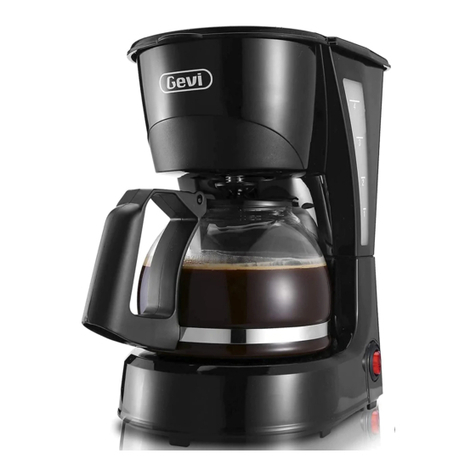
Gevi
Gevi GECMD008-U User manual
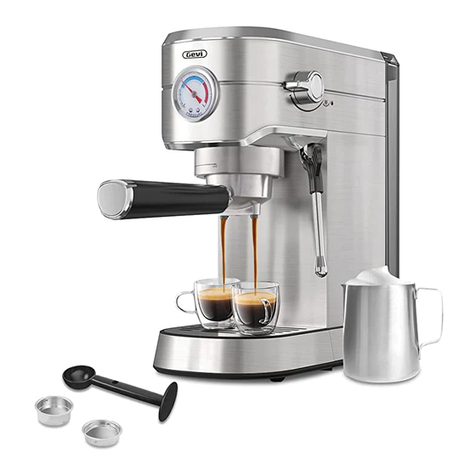
Gevi
Gevi GECME418E-U User manual
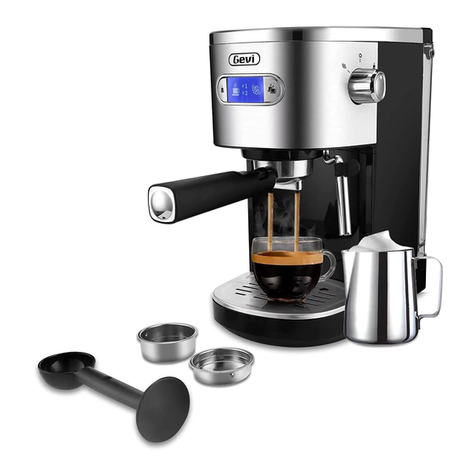
Gevi
Gevi GECME400BA-U User manual

Gevi
Gevi GECMA025A-U User manual
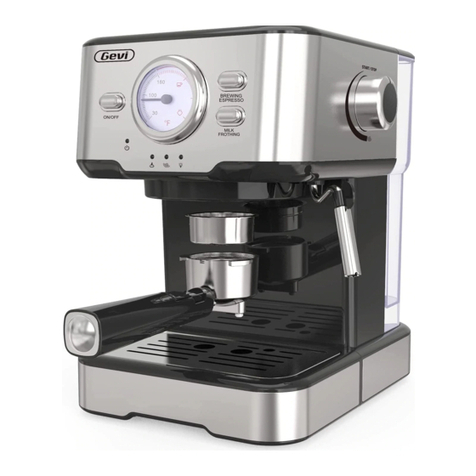
Gevi
Gevi GECME403-U User manual
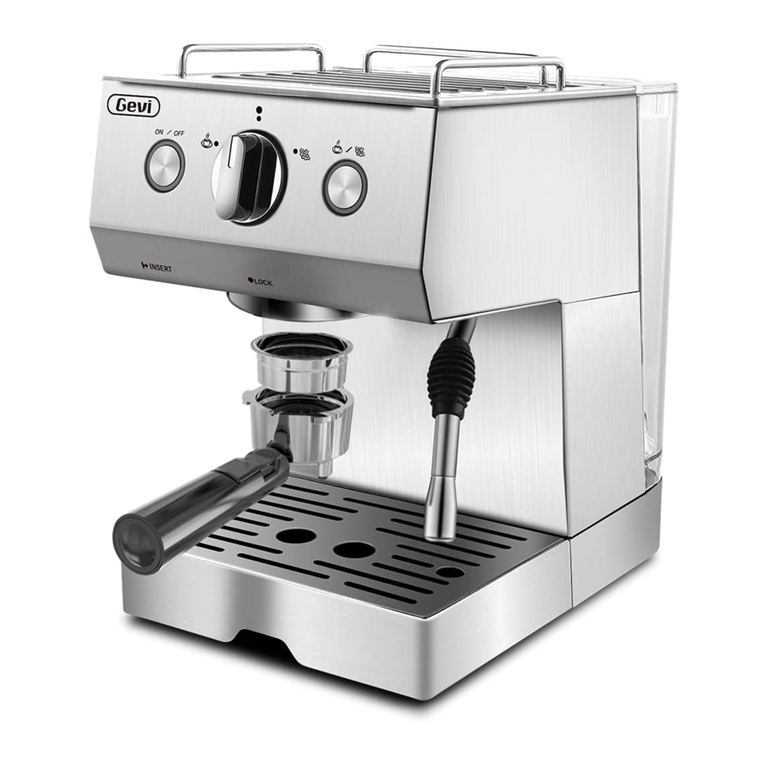
Gevi
Gevi GECME003D-U User manual
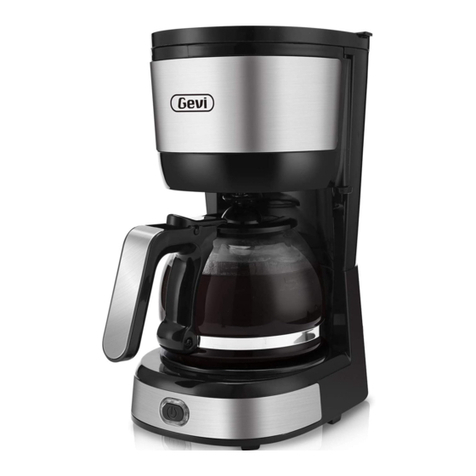
Gevi
Gevi GECMA409-U User manual
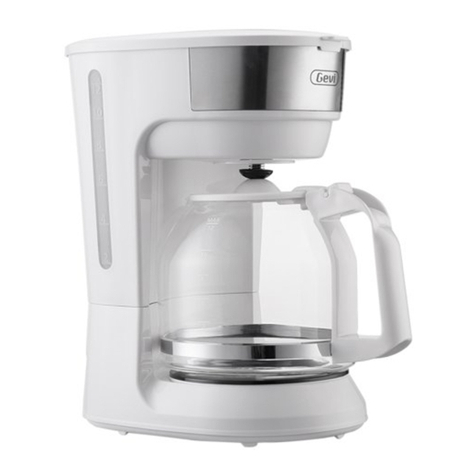
Gevi
Gevi GECMA091A-U User manual

Gevi
Gevi GECME400BA-U User manual

Gevi
Gevi GECME403L-U User manual

Gevi
Gevi GECMA409-U User manual
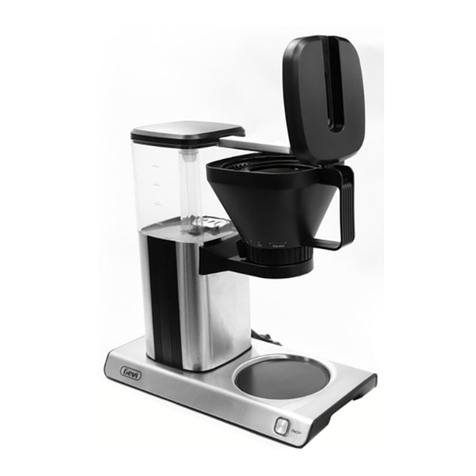
Gevi
Gevi GECMA068-U User manual

Gevi
Gevi GECMD329AE-U User manual
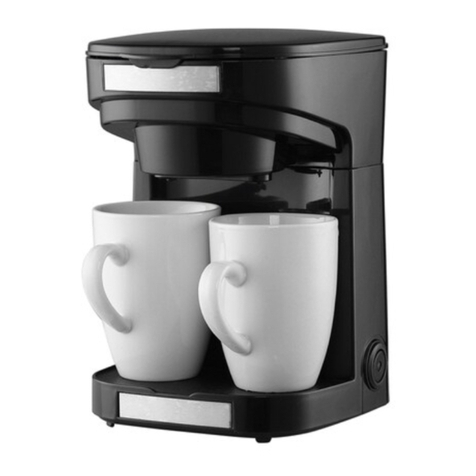
Gevi
Gevi GECMA160A-U User manual
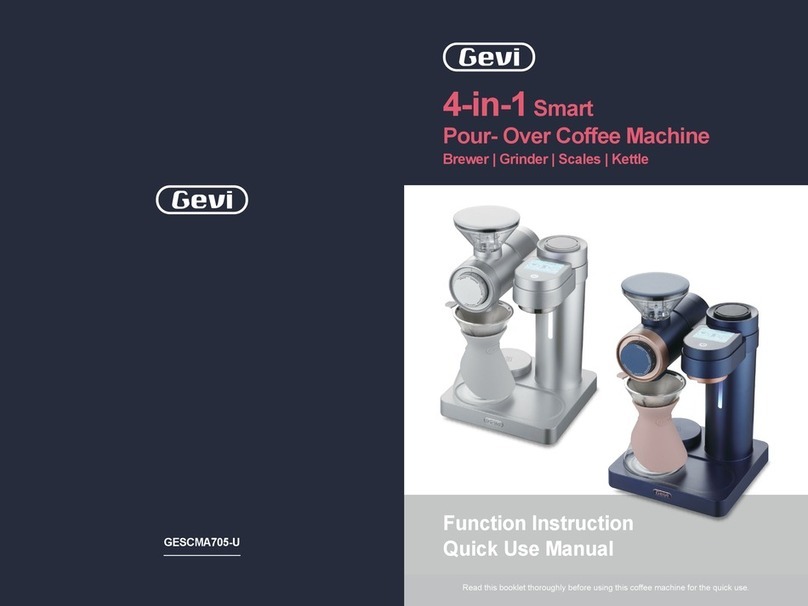
Gevi
Gevi GECME020DE-U User manual
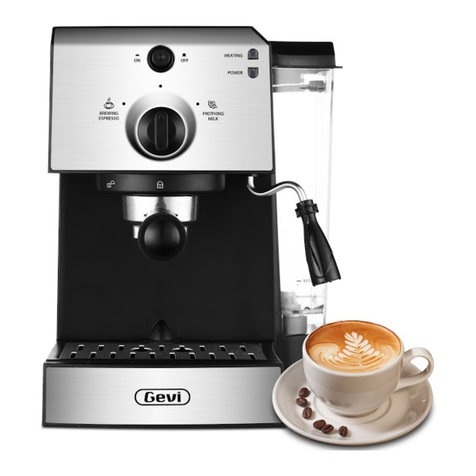
Gevi
Gevi GECMD627BK-U User manual

Gevi
Gevi GECME403-U User manual

Gevi
Gevi GECME022-U User manual
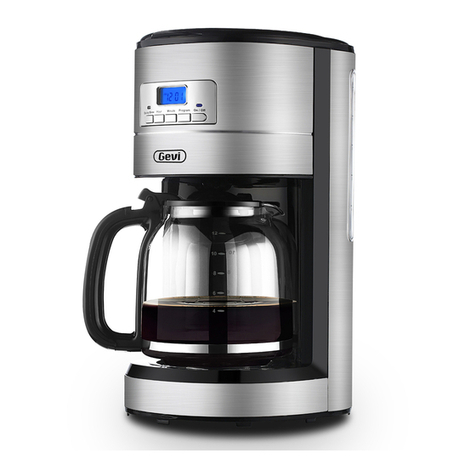
Gevi
Gevi GECMD276-U User manual
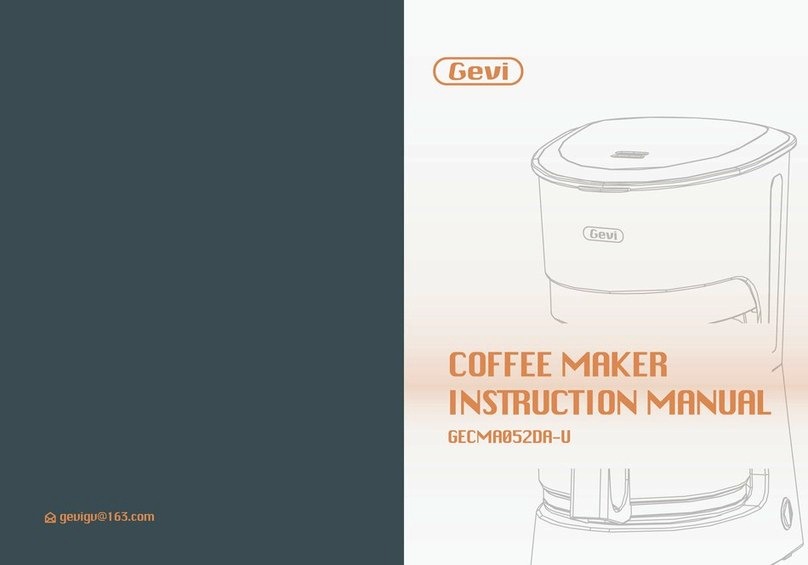
Gevi
Gevi GECMA052DA-U User manual


